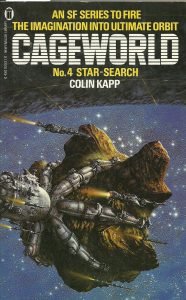Cageworld No. 4: Star-Search by Colin Kapp (book review).
Cageworld No. 4: Star-Search is the final slim volume of Colin Kapp’s series, where the crew of the Shellback embarks on one last mission—to see the stars beyond the Dyson spheres of the Sunara system. To achieve this, they must venture beyond the Pluto orbit. For the first time, we get a proper description of the illusionist Magician Cherry, who looks more like a guru than a performer in top hat and tails. Kapp also reveals that Zeus, in part, created the shells from interstellar dust, though one might wonder how much dust was needed to form such massive structures.
Former assassin Maq Ancor chooses a mostly different route, offering a fresh experience for readers who might have expected a rehash of previous journeys through the other cageworlds to reach the Pluto shell. This time, there’s a bit more actual science and even a touch more character development. The Shellback begins to show its age, requiring repairs. While Sine Anura contributes, Cherry’s former assistants, Tez and Carli, don’t play significant roles. The objective is to get beyond the Pluto cageworld and finally see the stars, an emotional discovery that contains spoilers.
Looking at the series as a whole, I don’t think Kapp did enough to explore these big dumb objects. Yes, he describes their size and the challenges the Shellback faces in navigating each cageworld and finding vents. However, I’m less convinced that human and sub-species populations would grow so large without someone suggesting birth control. Additionally, where is the space for agriculture to feed such massive populations?
I had one thought while reading this book, which also applies to other Dyson sphere stories: why only have habitable areas on the inside when the atmosphere could be extended to the outer surface? This would surely work with these cageworlds, as they are layer upon layer, and the sun devices could supply both sides. When you consider how many intermediary part-shells the AI Zeus created and how it moved people to fill them up, it makes me think Kapp may have focused on the wrong aspect. Perhaps we should have seen more of how these cageworlds functioned rather than just exploring them. Then again, these books were written some 40 years ago with different expectations.
Considering that “big dumb objects” is a recognized SF term, there haven’t been many such stories despite the vast number of SF books out there. This presents an opportunity for new SF writers to read, learn, and explore what else they can create. There are certainly enough ideas to delve into.
GF Willmetts
July 2024
(pub: New English Library, 1983. 171 page paperback. ISBN: 0-450-05531-0)


